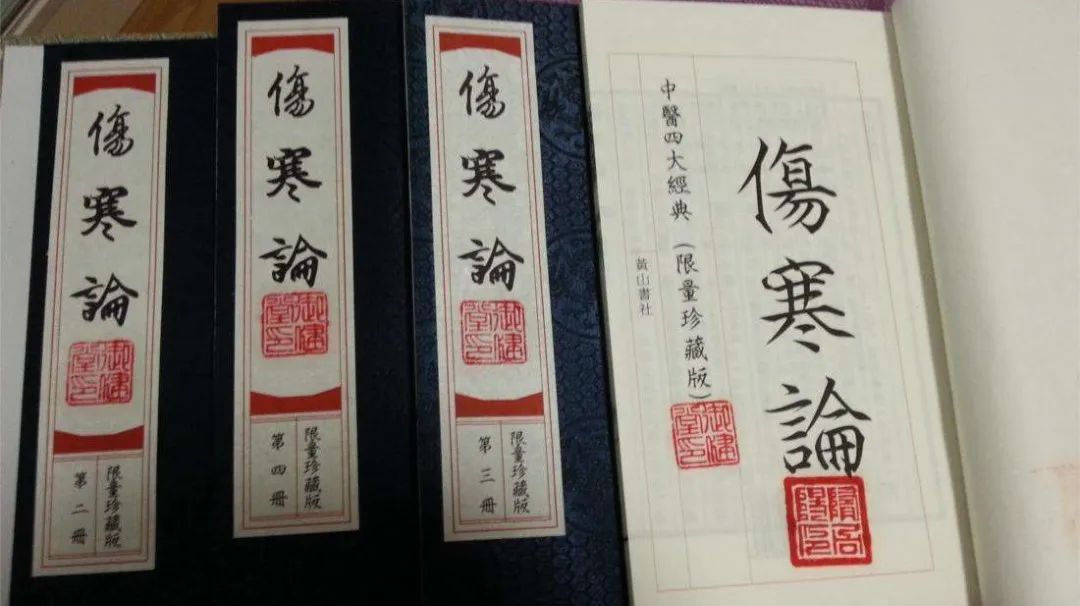Clickthe blue textto follow us
Discussion on Master-Disciple Relationships
Exterior and Interior Syndromes,
are among the earliest concepts encountered by students of Traditional Chinese Medicine (TCM).
Initially, it may seem confusing,
but over time, it becomes increasingly overlooked,
and the concepts of exterior and interior become more and more blurred.
Today, let’s re-familiarize ourselves with this “strange friend” around us.
01
The “Exterior and Interior” in Textbooks
The concepts of exterior and interior are a pair of principles used to differentiate the location of diseases and the depth of their severity. It is a relative concept.
In terms of the body structure, the exterior refers to the skin, while the interior refers to the organs;
in terms of the organs, the bowels are considered exterior, while the viscera are interior;
in terms of meridians and organs, the meridians are exterior, while the organs are interior, and so on.
From the perspective of disease severity, for external pathogens, if the pathogenic factor penetrates one layer into the interior, the disease is deeper; if it is at the exterior layer, the disease is lighter.
This understanding of relative concepts is particularly important in the differentiation of the six channels and the differentiation of defensive qi, nutritive qi, and blood. The above is the broad concept of exterior and interior.

The narrow concept of exterior and interior refers to the skin, muscles, and meridians as the exterior, where these areas are affected by pathogens, belonging to exterior syndromes; while the viscera, qi and blood, and bone marrow are considered interior, where diseases occur, belonging to interior syndromes.
1. Exterior Syndromes
Exterior syndromes refer to the symptoms produced when the six excesses and epidemic pathogens invade through the skin and mouth/nose. They are commonly seen in the early stages of external diseases, generally presenting acutely and with a short duration. Exterior syndromes have two distinct characteristics. First, they are caused by the invasion of pathogenic qi from the outside. Second, the condition is generally mild.
Clinical manifestations include: aversion to cold, fever, body aches, thin white tongue coating, floating pulse, along with symptoms such as nasal congestion, runny nose, cough, sneezing, and sore throat.
2. Interior Syndromes
Interior syndromes are a type of symptomatology where the disease is deeply rooted in the interior (viscera, qi and blood, bone marrow). They are contrasted with exterior syndromes. They are often seen in the middle to later stages of external diseases or in internal injuries. The scope of interior syndromes is very broad; apart from exterior syndromes, other diseases can be classified as interior syndromes. The characteristics of interior syndromes can also be summarized in two points. First, the disease is located deeper. Second, the condition of interior syndromes is generally more severe.
Clinical manifestations: The causes of interior syndromes are complex, with a wide range of locations and numerous symptoms, often appearing in forms of either cold or heat, or deficiency or excess. Here are a few common symptoms and pulses: high fever, aversion to heat or slight fever, irritability, thirst, or aversion to cold with cold limbs, fatigue, and a pale tongue with excessive saliva. Constipation, short and red urine, or loose stools, clear and long urine, abdominal pain, nausea, thick tongue coating, and deep pulse.
Due to differences in textbook versions, the above content may vary.
02
Reflections on the Textbook
Upon careful interpretation of this textbook section, several questions can be raised:
1. Are the clinical symptoms listed above referring to the broad or narrow concepts of exterior and interior?
2. Is the commonly used term for exterior and interior in daily conversation referring to the broad or narrow concepts?

Everyone should have encountered the concept of “relative” and should find it not particularly difficult to understand the “broad concept of exterior and interior.” However, it is necessary to discuss the narrow concept of exterior and interior in more detail.
3. It is stated that narrow exterior syndromes are commonly seen in the early stages of external diseases; does this mean that the early stages of external diseases necessarily equate to exterior syndromes?
03
Is Interpretation of Exterior and Interior Necessary?
1. Are the clinical symptoms listed above referring to the broad or narrow concepts of exterior and interior?
In fact, the answer to this question should be quite clear. I believe that the clinical symptoms of exterior and interior syndromes provided in the textbook refer more to the narrow concept of exterior and interior.
On the other hand, the broad concept of exterior and interior, in terms of viscera, meridians, muscles, bones, and the six channels, all have different clinical symptoms that are difficult to list exhaustively.
2. Is the commonly used term for exterior and interior in daily conversation referring to the broad or narrow concepts?
Perhaps influenced by textbooks or simply not paying attention, whether it is the general public or practitioners of TCM, the term exterior and interior often refers to the narrow concept of exterior syndromes.
Ancient TCM also derived some commonly used sayings, such as “If there is a bit of aversion to cold, there is a bit of exterior syndrome”; “If there is a bit of headache or body ache, there is a bit of exterior syndrome.”

Since the textbook has established the broad and narrow concepts of exterior and interior, clarifying the first question (the clinical symptoms of exterior and interior syndromes provided in the textbook refer more to the narrow concept of exterior and interior),combined with clinical symptoms, the textbook should not have confused the concepts of exterior and interior; it simply did not elaborate clearly.
In daily discussions about exterior and interior, unless it is for academic papers or reports, simply explaining the condition to patients does not require excessive interpretation of the concepts of exterior and interior, which may cause confusion. However, if it is for writing books, the concepts of exterior and interior may indeed require such explanations, or it may be better to use other terms that are more precise.
04
Is Exterior Syndrome Equal to Early Stage of External Disease?
Does the early stage of external diseases necessarily equate to exterior syndromes? This question has always been the most controversial.
Here, I will quote a statement from Professor Xiao Xiangru (Doctoral Supervisor at Beijing University of Chinese Medicine) for your reference.
The Origin of the Concept of “Exterior Syndrome”
The concept of “exterior syndrome” originates from the “Treatise on Cold Damage” (Shang Han Lun), where the Taiyang disease is considered an exterior syndrome.“Treatise on Cold Damage” is currently the primary literature for studying “exterior syndrome.”
The outline of Taiyang disease states: “In Taiyang disease, the pulse is floating, the head and neck are stiff and painful, and there is aversion to cold.”In the original text, the floating pulse, stiff and painful head and neck, and aversion to cold are all common clinical manifestations of exterior syndrome. However, only “aversion to cold” is specific, meaning that only “aversion to cold” is a characteristic manifestation of exterior syndrome.

The floating pulse, stiff and painful head and neck, etc., are also common in exterior syndromes, but they are not specific manifestations of exterior syndrome. In other words, although these manifestations are common in exterior syndromes, they are not exclusive to exterior syndromes.
Therefore, the key to determining whether it is an exterior syndrome lies in the presence or absence of “aversion to cold.” That is to say, “If there is a bit of aversion to cold, there must be a bit of exterior syndrome,” or it can be considered that “only with aversion to cold, can there be exterior syndrome.”
Exterior Syndrome is Not Caused by All Six Excesses
According to the “Treatise on Cold Damage,” Taiyang disease is an exterior syndrome, characterized by “aversion to cold,” with the cause of “aversion to cold” being cold evil, and the mechanism of its formation is that cold evil binds the defensive qi, preventing it from warming the flesh. The treatment for Taiyang disease includes two formulas: Ma Huang Tang (Ephedra Decoction) and Gui Zhi Tang (Cinnamon Twig Decoction).
Both Ma Huang Tang and Gui Zhi Tang have the effect of dispersing cold and are representative formulas for resolving exterior syndromes, targeting the cause of cold evil.
It is evident that exterior syndromes can only be caused by cold evil, and not by the “six excesses, epidemic pathogens, and other evils” as mentioned in TCM Diagnosis.Only cold evil has the property of binding and stagnating, which can bind the body’s defensive qi and produce “aversion to cold.” Other evils (except dampness) cannot cause exterior syndromes, especially heat evil.

What exactly is the definition of exterior syndrome? Understanding it clearly and reaching a consensus is surprisingly difficult. Here, I share Professor Xiao Xiangru’s two viewpoints, not necessarily to fully agree or disagree, but to provoke thought.
Another statement in the textbook caught my attention: “Exterior syndrome is a manifestation of the righteous qi resisting the evil from the outside; it should not be simply understood as a disease of the skin and other superficial areas, nor should it be mechanically assumed that superficial changes in the skin necessarily indicate exterior syndrome.”
Professor Hao Wanshan has also interpreted some passages of Taiyang disease from the perspective of righteous qi resisting evil, which remains refreshing and impressive even today; this may also be another way to understand exterior syndrome.
How do you understand exterior syndrome?
What doubts do you have about exterior syndrome?
Please leave a message to let us know.
– – – End of Full Text – – –
Observations
What is it like to see a “rebel” emerge from a family of TCM practitioners?
Hot Articles
Workers who died after returning to work, what is the Hantavirus?
Hot Articles
Little bugs, treating big diseases—several commonly used insect medicines for lung diseases
Hot Articles
Inheritance of Qi Huang, revitalizing TCM | 2020 Guangdong TCM Master-Disciple Spring Enrollment Guidelines

▍Copyright Statement:
○ Some materials and viewpoints in this article are derived from the “Xiao Xiangru Channel” and the internet, edited and organized by the Guangdong TCM Master-Disciple Education Research Center’s Publicity Department.
Editor | Hou Xi

Click [Read the Original]
to get more information on TCM Master-Disciple education
If you find the content good,
please give a [Like]🔻

